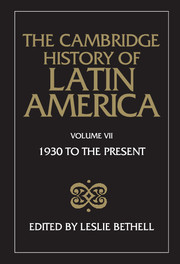3 - Central America since 1930: an overview
from PART TWO - CENTRAL AMERICA
Published online by Cambridge University Press: 28 March 2008
Summary
The establishment of stable nation states and permanent economic links with the world market through agricultural – especially coffee – exports took place in Central America during the second half of the nineteenth century. This process occurred first and most successfully in Costa Rica; later, and after much bloodshed, in Guatemala and El Salvador; and belatedly and incompletely in Honduras and Nicaragua. The backwardness inherited from the Spanish colonial period, the cyclical crisis in the international coffee market and the political struggles of the oligarchy for control of the government all slowed down economic growth, social progress and the development of institutional stability. Nevertheless, by the beginning of the twentieth century important changes had taken place in social stratification with the appearance of a coffee bourgeoisie and a small urban middle class, and political life was stable, though not democratic.
In 1914 the total population of Cental America was a little under 4 million, of whom nearly 60 percent lived in Guatemala and El Salvador. The basis of society – the agrarian structure – had three characteristics: large coffee estates controlled by national farmers producing for export; banana plantations, foreign-owned, with a vertically integrated production and marketing structure tied directly to the North American market; and small landholdings belonging to peasants who cultivated basic grains and other products for their own consumption or to satisfy internal demand. (Coffee and bananas accounted for 80 per cent of Central American exports.) The labour market was composed of mozos colonos, farmhands tied to the coffee haciendas by lifelong indebtedness; agricultural workers on U.S.-owned banana plantations; and – the largest sector – peasant smallholders, sharecroppers and migrant day-labourers who worked for wages during the harvest season.
- Type
- Chapter
- Information
- The Cambridge History of Latin America , pp. 159 - 210Publisher: Cambridge University PressPrint publication year: 1990
References
- 1
- Cited by



